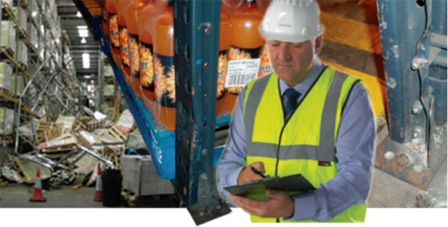
For your pallet racking installations, there is a risk that fork lift trucks can hit the racking. When they hit, they hit hard. And load-bearing uprights can suffer considerable damage.
At Link 51, we understand the consequences of structural damage to heavy load-carrying installations. Safety guidelines laid down by SEMA see it the same way.
All Link 51 products, not just pallet racking, conform to rigorous safety procedures. Theyʼre designed, manufactured and installed to do the job. Your peopleʼs safety is paramount.
But any damage affects integral strength and safety, and eventually reduces load carrying capacity. Even apparently harmless dents can lead to potential collapse.
The consequences? Letʼs not go there.
So you get it straightened out, right?
Before you do, know this. The most important racking component is the upright.
It canʼt just be beaten back into shape like a panel on a car. Hereʼs why:
Pallet racking uprights are load-carrying members.
Theyʼre predominantly made from strain-hardened, cold-worked steel - ideal for the job theyʼre meant to do. But once damaged there are no guarantees.
Tests on components ʻrepairedʼ in the best quality controlled environments show a marked drop in performance.
After being straightened, the properties of the racking are altered to an unknown degree so no manufacturer would guarantee its future performance.
In fact, in the absence of scientifically backed, industry-approved investigations that say it works, the repair of upright damage is a game of Russian roulette.
Do you want to play?
The thing to understand
Only the recommended replacement of damaged components with new components will maintain the required structural integrity of the racking. Simply straightening a damaged upright might appear an attractive, low-cost option. But no manufacturer with any integrity would advise you to do it.
1. The load carrying capacity could be reduced.
2. The structure weakened.
3. Human life put at risk.
Monitor, identify, act, prevent
Section 9.7.1 of European Standard EN 15635 - Steel static storage systems - application and maintenance of storage equipment clearly states: ʻRepairs to damaged components shall not be allowed unless approved by the equipment supplierʼ.
Regulation 5 of the Provision & Use of Work Equipment Regulations (1998) requires employers to ʻensure that work equipment is maintained in an efficient state, in efficient working order and in good repairʻ.
EN Standards, HSE guidelines and SEMA Codes all recommend that you inspect your racking regularly to make sure itʼs maintained properly and kept safe.
So do we. Here are the steps we urge you take.
Carry out weekly inspections of your storage equipment - just as youʼd service a vehicle.
Get in a qualified inspector at least once a year to conduct a full inspection - they will give you good advice on the effects of change of use/load, or reconfiguration of the rack geometry to suit new requirements.
If youʼre installing racking for the first time, buy from an experienced and knowledgeable provider working under SEMA design codes.
And get any repair/replacement approved by the manufacturer to avoid accidents and the liability for any potential failure.
Periodic rack safety audits not only make good business sense, but are also critical for every warehouseʼs successful planning and operation.
If you think you could live with any old repair, ask yourself if you could live with the consequences.